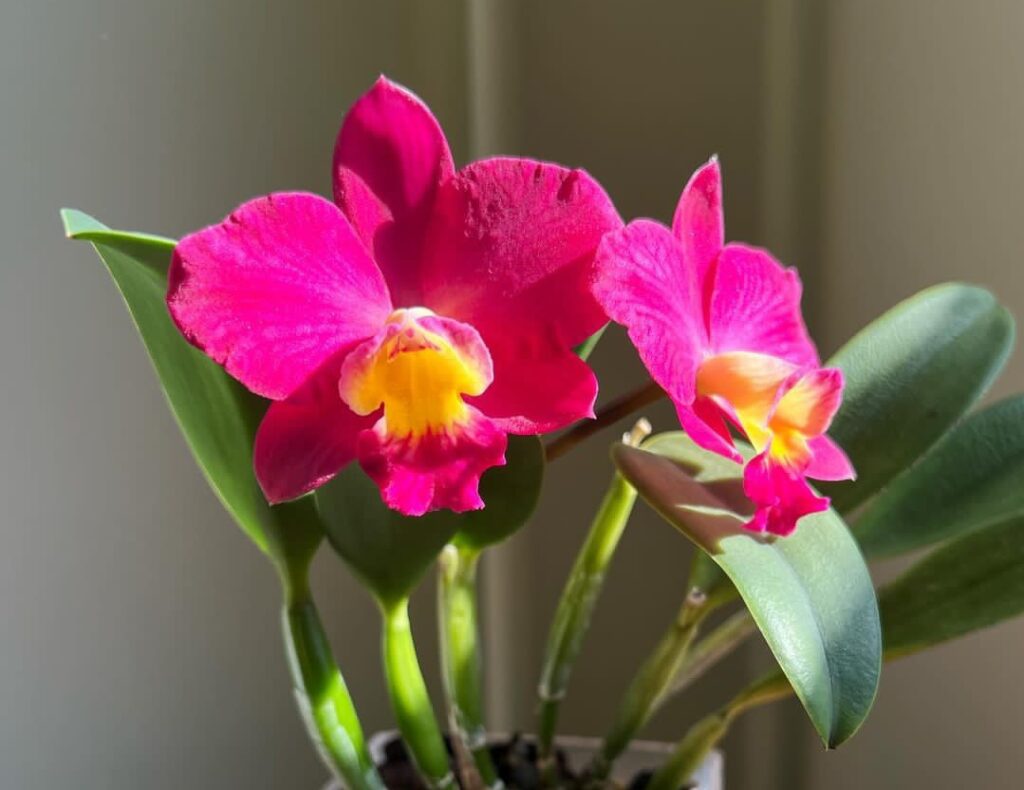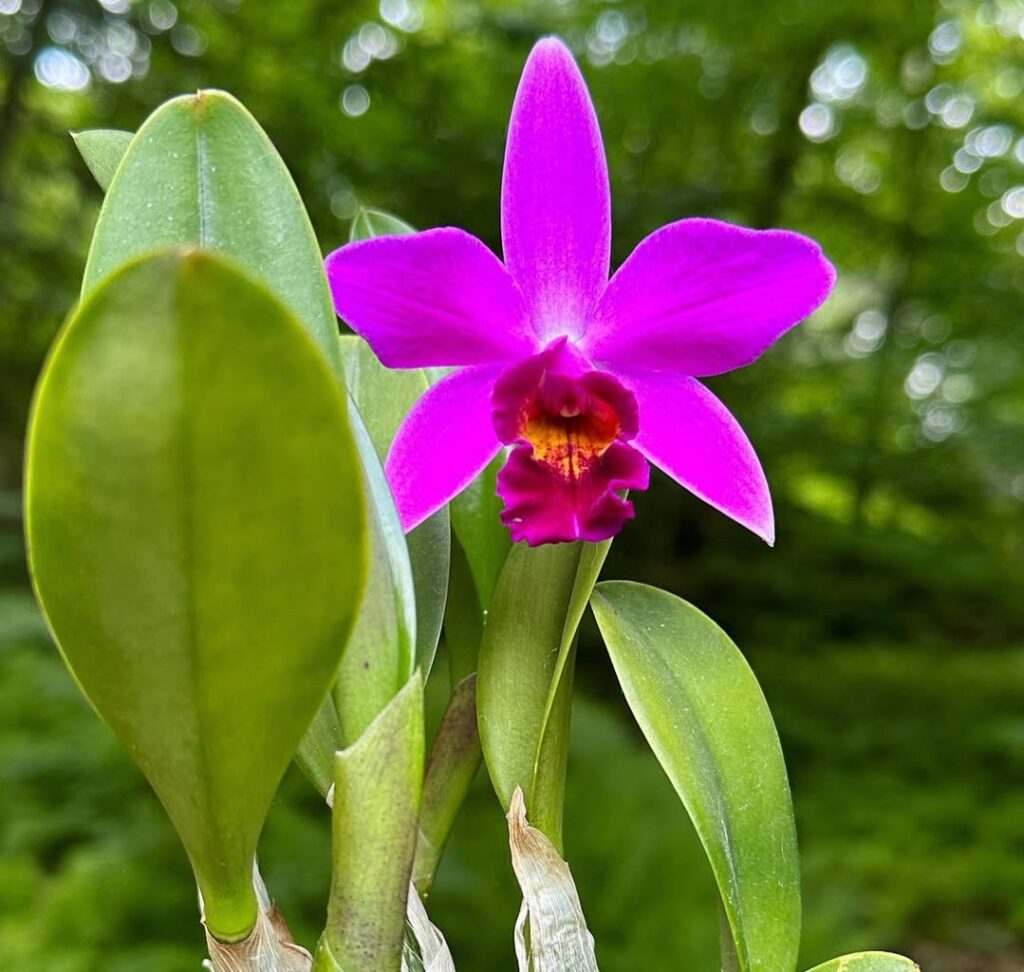
Cattleya orchids, often hailed as the “Queen of Orchids,” are beloved for their captivating beauty, fragrant blooms, and intricate floral patterns. These tropical epiphytes are native to Central and South America, where they grow naturally on trees in humid forests. Since their discovery in the early 19th century,
Cattleyas have become highly prized by orchid collectors, not only for their showy flowers but also for their diversity. Today, thousands of hybrids exist, offering a breathtaking array of colors, sizes, and bloom shapes. With proper care and attention, Cattleyas can become long-lasting additions to any orchid collection, blooming year after year.
Types of Cattleya Orchids

Cattleya orchids are divided into two main types based on their leaf structure: unifoliate and bifoliate. Understanding these types helps in providing tailored care to your plant.
Unifoliate Cattleyas
Unifoliate Cattleyas are characterized by a single leaf emerging from each pseudobulb. Large, eye-catching, and frequently fragrant blossoms are the hallmark of these orchids.The blooms typically feature frilled edges and come in shades of pink, white, yellow, and purple. Many popular hybrids belong to this group, such as Laeliocattleya and Brassolaeliocattleya hybrids. Unifoliate species are generally easier to care for and more forgiving when it comes to repotting.
Bifoliate Cattleyas
Bifoliate Cattleyas have two leaves per pseudobulb and produce clusters of smaller flowers. These blooms are often waxy and come in unique colors like green, brown, and orange, sometimes with striking spots or speckles. Bifoliate Cattleyas can be a bit more challenging to grow, as they are sensitive to root disturbance during repotting. Despite this, they reward growers with exotic-looking blooms that last longer than those of unifoliate species.
Growing Conditions for Cattleya Orchids
Cattleya orchids thrive when their environment mimics the warm, humid conditions of their natural habitat. Providing the right growing conditions is crucial for healthy growth and consistent blooming.
Location: A bright, airy location is ideal for Cattleyas. Indoors, place the orchid near a window that receives bright, indirect sunlight. Outdoors, they grow well in shaded areas where they can receive morning sunlight and be protected from the harsh afternoon heat.
Air Circulation: Good airflow is essential to prevent fungal diseases and promote healthy growth. If you’re growing indoors, use a small fan to maintain air circulation, especially in humid conditions.
Temperature and Humidity Needs
Cattleyas prefer intermediate temperatures, with a clear distinction between day and night temperatures to trigger blooming.
Daytime temperatures: Ideally between 70-85°F (21-29°C).
Nighttime temperatures: Around 55-60°F (13-16°C).
Maximum temperature tolerance:
Cattleyas can tolerate brief periods of heat up to 95°F (35°C), but only if humidity levels are high, and there is good airflow to prevent heat stress.
Humidity levels: Maintaining humidity between 40% and 70% is important for Cattleyas. If you live in a dry climate, use a humidity tray or mist the plant regularly. Make sure to mist early in the day so that the leaves have time to dry before dusk.
Light Requirements
Cattleyas need plenty of bright, indirect light to thrive. Proper lighting not only promotes healthy foliage but is also key to encouraging blooms.
Indoor lighting: Place your orchid near an east or west-facing window. If your window faces south, use a sheer curtain to block out the bright midday sun.
Outdoor lighting: When growing outdoors, position your orchid where it receives morning sunlight and afternoon shade.
Signs of proper lighting: Healthy Cattleya leaves should be light green. Dark green leaves indicate insufficient light, while yellowing or sunburn marks suggest too much direct sunlight.
Soil and Potting Tips
Cattleyas require a well-draining potting medium to prevent waterlogging and root rot. Unlike terrestrial plants, their roots need plenty of air.
Potting mix: Use a mix specifically designed for orchids, which may include bark, perlite, charcoal, and coconut husk chips. These materials allow air to circulate around the roots while retaining enough moisture.
Pot selection: Choose pots with good drainage holes. Clay pots are a great option, as they allow the roots to breathe and reduce the risk of overwatering.
Repotting: Repot Cattleyas every two to three years or when the potting medium begins to break down. Always repot after the orchid has finished blooming to minimize stress.
Watering Schedule
Watering Cattleya orchids correctly can be tricky, but getting it right is essential for healthy growth.
How to water: Water thoroughly, allowing the water to flow freely through the potting medium and drain out completely. This keeps the roots out of the water, which can cause rot.
When to water: Do not water again until the potting medium is nearly dry.This usually means watering once a week during the growing season and less frequently during dormancy.
Dormant period: During the orchid’s rest phase (after blooming), reduce watering to once every two weeks, and resume regular watering when new growth appears.
Fertilizing Cattleya Orchids
Fertilizing helps Cattleyas develop strong roots, healthy leaves, and vibrant blooms.
Overfertilization, however, may be more detrimental than beneficial.
Type of fertilizer: Use a balanced orchid fertilizer (20-20-20) diluted to 1/4 strength.
Frequency: Fertilize once a week during the active growing season. Reduce feeding to once every month during the dormant phase.
Flushing: Flush the pot with plain water once a month to remove any salt buildup from fertilizers.
Common Issues and Troubleshooting
Even with proper care, Cattleyas can encounter problems.Below are some common issues and solutions:
Yellowing Leaves
Cause: Overwatering, underwatering, or too much direct sunlight.
Solution: Adjust the watering schedule and provide filtered light. Ensure the potting medium drains well.
Root Rot
Cause: Overwatering or using a poorly draining potting mix.
Solution: Trim affected roots, repot in fresh medium, and allow the orchid to dry out slightly between waterings.
Failure to Bloom
Cause: Insufficient light, improper fertilizing, or lack of a temperature drop at night.
Solution: Increase light exposure, use a balanced fertilizer, and provide a clear day-night temperature difference of 10-15°F.
Pests
Mealybugs, scale insects, and spider mites are common pests.
Solution: Remove pests manually with a cotton swab dipped in rubbing alcohol or use an insecticidal soap safe for orchids.
By providing the right environment and care, your Cattleya orchids can reward you with stunning blooms and healthy growth year after year. With patience and attention to detail, even beginners can successfully grow these remarkable orchids





